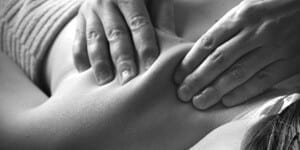GAD sufferers are often overly concerned about health issues, money, family problems or difficulties on the job. They can have negative, fearful thoughts about the future or suffer excessive guilt about some past event. These concerns can last for months and are often groundless. Physical symptoms associated with GAD include muscle tension/aches, fatigue, headaches, difficulty swallowing, twitching, irritability, sweating, nausea, lightheadedness, frequent urination, hot flashes and shortness of breath. Generalized Anxiety Disorder (GAD) affects about 6.8 million American adults. It affects twice as many women as men and its onset occurs gradually, beginning typically between childhood and middle age. A Surgeon General’s report on Mental Health revealed that 16% of adults between the ages of 18 and 54 suffer from various anxiety disorders for at least one year.
| For a different take, see Reflexology and Anxiety! |
Massage Therapy as a Treatment for GAD
One way to reduce the symptoms of GAD is through massage therapy. Various forms of therapeutic superficial tissue manipulation have been practiced for thousands of years to treat anxieties of various sorts. Therapeutic massage can be helpful in reducing anxiety and stress. Massage was shown to promote relaxation and alleviate pain and anxiety in hospitalized cancer patients.
Are you interested in becoming a certified massage therapist?
Visit the links below to explore our massage therapy programs at a campus near you:
Massage therapy can act to cleanse the body of impurities. It can, for example, help break down built up toxins or waste in muscles, and often has a calming effect on anxious patients. A good massage performed by a trained professional can help you relax and soothe the aches and pains in various parts of your body. While receiving a massage, one should avoid talking or dwelling on family, work or money matters. Instead, it’s best to relax and clear the mind. Keep in mind that it takes time for massage therapy to begin working. This means that persistent pains and tensions will require several sessions, so don’t expect immediate results.
Various Techniques in Massage Therapy
There are several different types of massage available today. There’s Deep Tissue massage, which reaches deep into the sub-layer of musculature and fascia. Practitioners need advanced training and a thorough understanding of anatomy and physiology to correctly perform this technique. Another popular technique is Swedish massage, which is a vigorous treatment designed to energize the body by stimulating circulation. It uses five basic strokes–kneading, rolling, vibration, percussive and tapping–to manipulate the body’s soft tissues. Chinese self-massage techniques can also help relax your body, ease tension and reduce anxiety. These self-massage methods seek to restore balance and harmony of the body’s various parts.They stimulate the flow of qi by kneading, rubbing, slapping, pinching or gently pounding the surface of the body.
Additional Considerations and Approaches to Treating GAD
When suffering from generalized anxiety disorder, first consult a primary care physician before attempting massage therapy. The may recommend the appropriate anti-anxiety treatment that is best suited for each individual case. In addition to massage therapy, the doctor may suggest certain anti-anxiety medications, psychotherapy or counseling, or even herbal remedies. If massage is suggested, find a licensed massage therapist who is nationally certified through the National Certification Board for Therapeutic Massage & Bodywork (www.ncbtmb.org) or the American Massage Therapy Association (www.amtamassage.org). Note: Medicare and most private insurance do not cover massage.
| For a different take, see Reflexology and Anxiety! |
Featured Posts:

